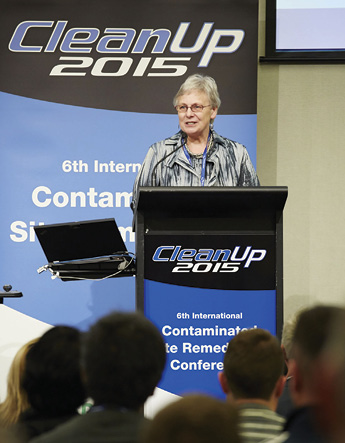Content
Regulator roundup 19
Regulator roundup 19
This edition of Regulator Roundup includes information about the new National Environment Management Plan, the merging of two certification schemes, EPA Victoria’s new chairperson and the NSW Government’s recent commitment for contaminated land management funding.
PFAS National Environment Management Plan released
A National Environment Management Plan (NEMP) for per- and poly-fluoroalkyl substances (PFAS) was approved by Australian, state and territory environment ministers in February 2018. All state and territory environment protection authorities (EPAs) and the Australian Government developed the NEMP, under the leadership of EPA Victoria.
PFAS have multiple industrial uses, including as components in firefighting foams, nonstick cookware, food packaging, insecticides, and waterproof and fire-resistant fabrics. PFAS are very stable and can accumulate in the environment, and in the bodies of the people and animals exposed to them. Regulators in Australia and several other countries have been developing guidelines for the assessment and management of PFAS, because of the growing concerns about their effects on human health.
According to EPA Victoria, ‘The PFAS NEMP provides governments with a consistent, practical, risk-based framework for the environmental regulation of PFAS-contaminated materials and sites’.
CRC CARE published interim guidance on the assessment, management and remediation of 2 PFAS (PFOS and PFOA) in 2017. It is planning to update its guidance to complement the recommendations in the NEMP.
The NEMP can be downloaded from the EPA Victoria website.
Contaminated site practitioner certification schemes merge
CRC CARE’s Site Contamination Practitioners Australia (SCPA) and the Environment Institute of Australia and New Zealand’s Certified Environmental Practitioners Scheme (CEnvP) have merged into an amended certification scheme for site contamination specialists. The CEnvP brand will host the unified scheme. SCPA members and CEnvP Contaminated Land Specialists have been transitioned to the new initiative, which will incorporate elements of both previous schemes. The NSW EPA has already recognised the new scheme.For more information, visit the CEnvP website.
EPA Victoria chairperson appointed
Ms Cheryl Batagol has been appointed chair of the new EPA Victoria Governing Board, which is being reconstituted under the Victorian Government’s EPA reform process.
Ms Batagol, who has been the EPA chair under its current governing structure since 2009, has more than 40 years’ experience in the waste management, water and environment sectors. As EPA chair, she has had a close association with CRC CARE and was instrumental in bringing the CRC CARE CleanUp Conference to Melbourne in 2013, 2015 and 2017.
Ms Batagol’s 2-year appointment will take effect from 1 July 2018 when the new Governing Board starts and the Environment Protection Act 2017 comes into effect. In January, an interim advisory board was established to advise Ms Batagol about delivering agreed reforms as part of the government response to the Victorian Government’s Independent Inquiry into the EPA.

EPA Victoria Chair Ms Cheryl Batagol presents the Brian Robinson memorial lecture at CleanUp 2015, Melbourne
New funding for NSW contaminated land management
In November 2017, the NSW Government announced that it will dedicate an additional $23.5 million to the NSW EPA for contaminated land management.
The government will implement 75 recommendations from 3 external reviews:
- Macquarie University Professor Mark Taylor’s Review of the New South Wales Environment Protection Authority’s management of contaminated sites: final report
- the Lead Expert Working Group report on managing residual lead contamination in north Lake Macquarie
- the Fell and Leeder Review of the EPA’s Contaminated Land Management Act 1997 procedural guide.
The 75 recommendations will be adopted into 8 priority areas designed to improve the EPA’s operations:
- clear the backlog of contaminated sites
- target illegal waste disposal with tougher regulations
- improve the capacity of planning authorities in contaminated land management
- improve public access to information
- review and strengthen the Contaminated Land Management Act 1997
- investigate options to improve the waste and environment levy
- establish a new independent expert technical and scientific panel, and an environmental sampling capability for emerging contaminants within the EPA
- improve management of large-scale emergency clean-up, and orphaned, abandoned or high-risk sites.
In January 2018, the NSW Department of Planning and Environment announced that it is reviewing the State Environmental Planning Policy (SEPP) for the remediation of land and the Contaminated land planning guidelines as part of its wider policy review program. A proposed Remediation of Land SEPP will:
- provide an updated and a clear statewide planning framework for land remediation
- require consent authorities to consider the potential for land to be contaminated when determining development applications
- clearly list the remediation works that require development consent
- introduce certification and operational requirements for remediation works that can be undertaken without development consent.
More information is available on the NSW Government website.